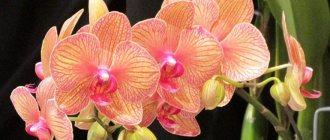Author: Elena N. https://floristics.info/ru/index.php?option=com_contact&view=contact&id=19 Category: Houseplants Published: January 18, 2019Last edits: January 11, 2021
- Rules of care
- How to transplant
- Cyclamen turns yellow
- European cyclamen, or alpine violet
Blooming cyclamens, along with poinsettias, are often presented as a Christmas or New Year's gift. This plant is very beautiful and hardy: some cold-resistant varieties of cyclamen can withstand temperatures of thirty degrees. However, sometimes you can hear: “Don’t give me cyclamen, they die quickly.” Indeed, this happens quite often. And all from the fact that you need to know how to care for alpine violets, and if you master this simple wisdom, the handsome cyclamen will become a long-liver on your windowsill. We will tell you about all the intricacies of caring for cyclamen, and there will always be a beautiful bouquet on your windowsill for Christmas.
Planting and caring for cyclamen
- Flowering: early spring, autumn, sometimes all year round.
- Lighting: bright diffused light, light partial shade.
- Temperature: 6-12 ˚C.
- Watering: during the period of active growth, regular, moderate, using bottom watering.
- Humidity: higher than usual.
- Feeding: once every two weeks with a solution of complex mineral fertilizer for flowering indoor plants in a weak concentration.
- Dormant period: within 2-2.5 months after flowering.
- Replanting: once every two years at the end of the dormant period.
- Reproduction: by seeds and by dividing the tuber if it has more than one growing point.
- Pests: spider mites, aphids, thrips, cyclamen mites.
- Diseases: gray rot, rhizoctonia, late blight, fusarium wilt.
Read more about growing cyclamen below.
plant (lat. Cyclamen) belongs to the genus of herbaceous perennials of the Myrsinaceae family, although some scientists classify it as a member of the Primrose family. The plant's name comes from a Latin root meaning "round", like the shape of cyclamen tubers. The genus has about 20 species. In nature, the cyclamen flower is widespread in the Mediterranean, Iran and North-East Africa, but most of all in Turkey. Some types of cyclamen are successfully grown as indoor plants. Diluted cyclamen juice is used to treat sinusitis, but care should be taken as it can burn the mucous membrane.
When to plant a beauty
With the onset of spring, nature transforms, presenting humanity with the delicate and subtle aromas of blossoming flowers. Warm summer only enhances the brightness of the colors, adding variety to the many created flower beds, and gives an unlimited amount of positive emotions. However, most people do not even suspect that even in the cold season you can get fragrant and bright cyclamen on your windowsill. The main thing is to know when to plant and how to care for this miracle.
The process of sowing and growing this plant from seeds is very simple and even the most novice gardener can master it.
The only difficulty is to remember three points, following which the germination and good growth of cyclamen is ensured:
- Preparing soil for seedlings;
- Seed preparation;
- Choosing a sowing method.
It would seem that the name of the points speaks for itself, but each of them needs to be dealt with separately.
Features of cultivation
The cyclamen root is a flattened round corm up to 15 cm in diameter with a single growing point. Damage it and destroy the bulb. Cyclamen leaves are basal, leathery, heart-shaped, growing on petioles up to 30 cm long, dark green in color with a grayish-silver pattern. The original shape of the flowers is similar to outlandish butterflies - the petals are bent and pointed, sometimes have a fringed shape, and the color palette is incredibly wide - boiling white, pink, all shades of red, burgundy and purple. Cyclamen blooms for longer than three months.
There is an opinion that indoor cyclamen is a capricious plant. Don't believe it! Cyclamen is unpretentious, it’s just that its agricultural technology, like the agricultural technology of any other plant, has certain requirements, the obligatory fulfillment of which will allow you to easily cope with its cultivation. So:
- When to fertilize flowers
- Do not under any circumstances store faded cyclamen tubers in the refrigerator - after such storage the bulb will not wake up;
- the cyclamen flower does not tolerate heat and stuffiness, but lives well in a cool room at a temperature that is uncomfortable for humans - only 6-12 ºC;
- direct sunlight can cause burns on the beautiful cyclamen leaves;
- do not bury the cyclamen tuber in the ground: at least a third of the bulb should remain on the surface;
- cyclamen does not tolerate excess mineral salts in the soil, so be careful with fertilizers;
- The pot for cyclamen needs to be small, so that from the bulb to the wall of the pot there is a layer of soil no thicker than 2-3 cm.
They also often look for cyclamen instead of cyclamen. It's nothing. We will tell you how to grow both flowers.
In the photo: White cyclamens in a pot
Growing cyclamen from seeds
How to sow seeds
A species such as Persian cyclamen reproduces by seeds. Cyclamen seeds are sown in February or March, although cyclamen grown at home can be propagated at any time of the year. On the eve of planting, soak the seeds for 12 hours in a pale pink solution of potassium permanganate or in Epin or Zircon preparations prepared according to the instructions. After this, sow the seeds in an earthen mixture for cyclamen, consisting of two parts of pre-steamed soil, one part of a soil mixture such as “tulip” or “terra vita” and half of river sand to loosen the soil.
It will be better if you make a groove 1 cm deep in the soil, pour it well with water and place the seeds in it 2-3 cm apart. Sprinkle the seeds with a layer of soil on top and cover the container with glass or film.
At a temperature of 18-20 ºC, seeds germinate in 30-60 days, although there are slow-growing varieties that germinate in five or more months!
Planting cyclamen
When sprouts appear, remove the cover and move the container with them to a more illuminated place, but away from direct sunlight! When two true leaves appear, the seedlings sprout 2-3 seedlings into one pot, completely covering the nodules with soil. The soil should be loose, such as a “tulip” mixture or the same mixture in which you sowed the seeds. After 6-7 months, you can transplant the grown cyclamen into pots with a diameter of 6-7 cm with the same soil mixture. Planting cyclamen in this case requires deepening the corm no more than two-thirds of its size so that the growing point rises above the soil surface. If you care for cyclamen at home correctly, you will be able to see it bloom a year and a half after sowing the seeds.
In the photo: Growing cyclamen outdoors
Caring for home cyclamen
Rules of care
Cyclamen is a flower that requires bright, indirect light and cool (6-12 ºC) temperatures. In addition, you will have to frequently ventilate the room, but under no circumstances create drafts in it - this is unacceptable for cyclamen. Frequent spraying will make the air humidity in the room higher, which cyclamen really likes; in addition, it can reduce the temperature by a couple of degrees in the summer heat. The plant also needs fertilizing with complex fertilizer for flowering plants, but be careful with the consistency - it is better to underfeed this plant than to overfeed it.
- Photos and names of araucaria
How to water
During the period of active growth, cyclamen requires regular watering, but try to avoid fanaticism in this matter: watering should be sufficient, but not excessive.
To be sure that the plant has enough moisture, use the bottom watering method - place the pot with cyclamen in a container of water and keep it in it until the top layer of soil gets wet, then remove the pot from the water and allow the excess to drain . This method, by the way, will not allow moisture to get to the top of the tuber, where the growth point is located, thereby minimizing the risk of plant rotting.
Reproduction
Cyclamen reproduce by seed, which we described in detail in the previous section, and by vegetative means by dividing the tuber. But only those corms that have more than one growing point can be divided, and this happens very rarely. In addition, the process of dividing and rooting part of a tuber for an amateur often ends in failure, so we can assume that the seed method of propagating cyclamen is the only possible one.
In the photo: Cyclamen in a pot outdoors
Cyclamen after purchase
How to care for cyclamen immediately after purchase? Sometimes the next day after you bring the purchased cyclamen home, it drops flowers and even leaves. Don't panic - this is completely natural behavior for cyclamen. He needs to get used to your environment, and you try to create for him the conditions in which he will be comfortable. The cyclamen flower should occupy the brightest and coolest place in the house.
Check the substrate, and if it is dry, give the plant a drink using bottom watering or watering in a pan - in these cases, the plant will receive exactly as much moisture as it needs. Be sure to spray the plant. Do not feed cyclamen for two to three months after purchase - plants that go on sale are well and long-term fertilized.
Secrets to the success of growing eustoma on a windowsill
Bloom
Cyclamen blooms either in summer or winter, and the time, that is, the duration of the plant’s flowering, directly depends on how you follow the rules for caring for cyclamen. Let us recall that the optimal conditions under which cyclamen will bloom long and profusely are as follows: a lot of light, but without direct sunlight; The optimal temperature for flowering is not lower than 10 ºC and not higher than 20 ºC. Water either from the bottom or in a tray so that moisture does not get on either the growing point or the leaves with flowers. Trim faded flowers.
- How to replant violets
FAQ
- Cyclamen: why do the leaves turn yellow?
Most likely, the temperature in the room is too high and the air is too dry. If the room temperature is higher than +16-17 C, then cyclamen will not tolerate it well. Yellowing leaves may be a result of improper watering. Too much sun shining on the leaves of the plant causes yellowing or burns.
- Cyclamen: why doesn’t it bloom?
In order for cyclamen to bloom in winter, it must rest well in the summer. Inexperienced gardeners who do not reduce watering in the summer watch as the flower grows more and more leaves. Because of this, the tuber is depleted: it uses up all its nutrients. Therefore, flowering does not occur in winter. However, you should not rush to the other extreme - overdrying the root in the summer. Because of this, he will be active late in winter. Cyclamen blooms in cool, humid climates. If it is too hot, there is a possibility of pest infestation. A minimum of fertilizers should be provided: nitrogen, phosphorus, potassium. In winter there is usually poor lighting; you can add additional lighting for the flower.
Replanting cyclamen
How to transplant
Cyclamen is replanted into a new substrate about once every two years if the pot has become too small for the bulb. This should be done at the end of the dormant period before the start of active growing season.
But remember that cyclamen does not need a spacious pot; it blooms well only in a cramped one, when the layer of earth from the bulb to the wall of the pot is no thicker than 2-3 cm. For example, for a bulb 1-1.5 years old, a pot with a diameter of 7-8 cm is suitable , and for a two to three year old bulb – with a diameter of 14-15 cm.
In a new pot, place expanded clay for drainage, a layer of fresh substrate, then the bulb along with an earthen lump and roots and add enough substrate so that the tuber is two-thirds immersed in it. Compact the soil well. The transplanted cyclamen will need fertilizer no earlier than in a month.
In the photo: Cyclamen flowering
Replanting after purchase
After purchase, cyclamen is replanted only if it is in a dormant period, which in itself is strange - who buys a bulb buried in the soil? If you bought a flowering cyclamen, wait for it to bloom and rest, and then, at the very beginning of the growing season, if the bulb is cramped or you want to change the technical plastic pot to a beautiful one, replant the cyclamen in the manner described. Or, if the plant is doing well in an old pot, it is better to place the ugly pot of cyclamen in a beautiful planter.
Pests and diseases
If you follow the rules for caring for cyclamen, neither insects nor viral or bacterial diseases threaten your flower, but improper care of cyclamen at home can lead to rotting of the bulb due to chronic waterlogging of the soil or to the appearance of spider mites due to insufficient watering. Correct your mistakes as quickly as possible and do not make them again, and then neither the cyclamen nor you will have problems with it.
Cyclamen turns yellow
If you follow the rules for watering the plant, but the cyclamen flower still turns yellow, it means it may simply be too hot. Spray it as often as possible and, if possible, find a cooler place for it, otherwise the cyclamen flowers may begin to dry out from the heat.
If the leaves begin to turn yellow after the cyclamen has bloomed, it means that it is simply preparing for a dormant period, and your concern is in vain.
In the photo: Blooming cyclamens in open ground
Cyclamen does not bloom
If the cyclamen receives little moisture when watering or if you do not take care of the required level of indoor air humidity, you are unlikely to see the cyclamen bloom. Cyclamen does not bloom in too warm a room, especially if it is not used to such a temperature. Sometimes, over time, the plant gets used to the high temperature in the home and, if all other conditions are met, the cyclamen eventually begins to bloom.
Possible problems
Most often, when growing cyclamen and violating the rules of caring for it, the following problems may arise:
- Leaf or flower petioles rot. The reason for this situation is inappropriate temperature conditions or careless watering;
- gray rot appears on buds and flowers. The provoking factor is low temperature, high humidity and poor air exchange in the room;
- short flowering phase - this phenomenon is caused by inappropriate temperature or watering conditions.
Cyclamen after flowering
When flowering ends, the leaves of the cyclamen gradually turn yellow, indicating that it is preparing for a period of dormancy. It is better to remove yellow leaves, but not to cut them, but to twist them until they separate from the bulb. Watering is gradually reduced and the tuber resting in the ground is watered only occasionally, moving the plant to a shaded place until the cyclamen again shows signs of life.
Another winter-blooming flower – violets: care tips
Forum, reviews from flower growers
Flower growers prefer dry wood because of its high decorative value and the opportunity to admire the bright colors in winter. A few tips from experts will help beginners organize proper care for a luxurious representative of indoor flora:
· Victoria recommends periodically pampering the crop with organic fertilizer. The florist claims that when applying any fertilizer, it is important to avoid contact with the crown and underground organs.
· Tatyana managed to successfully separate the Persian onion. The secret is that when planting, only a third of the underground organ needs to be buried. This method will avoid rotting of the corm. When the cuts are completely tightened, you can add soil to the required level.
· During the dormant period, Roman puts the flower pots in a dry, ventilated basement. For the flower at this time, the presence of light does not matter, and in the basement it is easier to maintain the necessary wintering conditions.
Important! Many gardeners note that dryweed is one of the plants that is best not to overfeed, otherwise moths will never appear above the bush.
Kinds
Mainly two types of cyclamen are grown in culture - Persian and European, as well as their derivatives.
European cyclamen, or alpine violet
This is a tuberous plant with medium-sized leaves and fragrant pink-lilac flowers, but it has varieties of white, carmine and other colors. In culture since 1607. European cyclamen is much more tolerant of normal home temperatures than other species, but also prefers cool air to stuffiness. This species does not have a pronounced dormant period; in addition, its tubers sometimes grow daughter bulbs that can be used for propagation. European cyclamen blooms from late spring until almost winter; it feels great in the summer on the balcony or in the garden, but under mandatory protection from sunlight and from penetration of slugs and earthworms into the pot, for which purpose the pot is covered with an ordinary nylon stocking.
In the photo: European cyclamen, or alpine violet
Persian cyclamen, or dryweed
It is more popular in culture than all other species due to the incredible beauty of its flowers, which, when they bloom, seem to turn inside out and grow with their petals down until the plant sheds them without any traces of wilting. The color of the flowers is pink, dark purple, lilac, white, hot pink, and in most cases the flower throat is a different shade. The leaves of the Persian cyclamen are larger and more beautiful than the European ones; they are not inferior to the decorative flowers. Recently, dwarf varieties of Persian cyclamen have become very popular, which tolerate room temperature much better than specimens of large varieties. Persian cyclamen blooms from late autumn to early spring, and then there is a 9-month dormant period. In culture since 1731.
In the photo: Persian cyclamen, or dryweed
In addition to these two most popular species in indoor floriculture, there are also African cyclamen, Kos cyclamen, Cyprus cyclamen, Greek cyclamen, amazing cyclamen, small-flowered cyclamen, Cilician cyclamen and other species that are found mainly in the wild.
Photos in the interior
With good care and favorable conditions, Cyclamen can decorate the windowsill of any home with bright colors. This plant gives a feeling of warmth and comfort, fills rooms with a delicate aroma and delights with its beauty all winter long. Growing Cyclamens is very exciting, and the wide variety of varieties and species allows you to organize a colorful flower bed right on your window.
FAQ
Why do cyclamen leaves curl? The reason may be a decrease in immunity due to poor nutrition: use complex mineral fertilizers to feed the plants.
If the flower is in close proximity to heating devices, especially during the flowering period, this can also cause the leaves to curl. At this time, the optimal temperature for the plant is 14 ⁰C, but it is necessary to ensure that the cyclamen is not exposed to a draft.
Leaves can react in a similar way to the appearance of pests. Carefully inspect the plant and if mites or insects are found, treat with the appropriate preparation.
It is also important to observe the correct watering regime: under no circumstances should the soil be allowed to become chronically waterlogged. Cyclamen tolerates drought much more easily than overwatering.
Determine the cause, eliminate it and strictly adhere to the rules of caring for the plant in the future.
Cyclamen has dropped its leaves - what are the reasons?
“Cyclos” is translated from Greek as “circle”, “wheel” or “ring”. Cyclamen tubers have an almost perfect round shape. Apparently, it was this feature that was the reason that the plant was called cyclamen. However, there is an opinion that the name “cyclamen” is associated with the flowering cycle, although this justification seems somewhat strained to us.
The scientific name cyclamen came into our language from the French language.
This plant has other names: dryakva, pork bread, alpine violet, but “cyclamen” is the most common and familiar name. Why is cyclamen called that?
“Cyclos” is translated from Greek as “circle”, “wheel” or “ring”. Cyclamen tubers have an almost perfect round shape. Apparently, it was this feature that was the reason that the plant was called cyclamen. However, there is an opinion that the name “cyclamen” is associated with the flowering cycle, although this justification seems somewhat strained to us.
The scientific name cyclamen came into our language from the French language.
This plant has other names: dryakva, pork bread, alpine violet, but “cyclamen” is the most common and familiar name. Cyclamen changes color - why?
This usually happens when two tubers of different varieties are planted in a pot: one plant produces, for example, crimson flowers, and the other produces white ones. But sometimes it happens that the same tuber produces flowers of different colors. This is usually due to insufficient lighting.
If you bought a crimson-colored cyclamen, and suddenly discovered that the new buds and flowers have noticeably turned pale and become almost white, move the flower to the lightest windowsill. Even daily sunbathing in the morning or after 4 pm will not harm this plant.
Sometimes this effect occurs due to a deficiency of fertilizers or is the result of a mutation.
What soil is suitable for cyclamen?
The soil pH for cyclamen should be within 5.5-6.5 units. If you don’t want to bother with preparing the soil mixture, you can buy “Tulip” soil or soil mixture for begonias in the store, but you will need to add sand to it, sprinkle it with Fitosporin-M, and then add wood ash.
You can mix the soil yourself by taking 4 parts of turf soil, 2 parts of sand and greenhouse soil and adding 1 part of sand.
There is another recipe for which you will need equal parts of leaf soil, peat and baking powder - sand or agroperlite. Mix the ingredients thoroughly and pour the resulting mixture with Fitosporin-M or a boiling pale pink solution of potassium permanganate. How does Persian cyclamen differ from European cyclamen?
European cyclamen (alpine violet) does not have a pronounced dormant period and can bloom for up to 9 months in a row. It easily adapts to the room temperature, without particularly suffering even in the summer heat. However, he still prefers cool air. This plant has small flowers and leaves, and is inferior in decorativeness to the Persian species of cyclamen
Persian cyclamen (dryakva) is distinguished by large, incredibly beautiful flowers and no less attractive large leaves covered with a light intricate pattern.
But many lovers of indoor plants complain about the capriciousness of this species: Persian cyclamen requires a certain temperature and lighting. Difficulties often arise with watering the tree. However, recently dwarf hybrids have appeared that can tolerate the warm air of our apartments much more easily and are not so demanding on other living conditions. Do I need to prune cyclamen?
The so-called pruning of cyclamen is carried out after flowering is completed: yellowing leaves and faded flower stalks are removed.
Moreover, the flower arrows should not be cut off, but twisted at the base until they separate. If the flower stalks are cut off, the remaining stumps can cause the tuber to rot. At the same time, you need to greatly reduce watering and completely abandon fertilizing to give the plant the opportunity to recover. How to propagate cyclamen vegetatively?
European cyclamen is propagated by two vegetative methods: tuber division and rosettes. Plants no younger than four years old with a developed root system are suitable for this. Using a sterile knife, cut the tuber in half so that each section has a shoot and a root. The sections are sprinkled with charcoal powder and dried for 24 hours. Then the halves are planted in pots filled with drainage and suitable soil.
If your cyclamen forms horns (rosettes), separate the shoot at the very base, immediately plant it in a moist substrate and cover with a glass jar. Typically, rooting occurs within two to three weeks, and then the young cyclamen begins to form a tuber.
Persian cyclamen can also be propagated either by division or by rosettes, but the shoots of this species take root very poorly: out of ten horns, only one takes root.
As for dividing the tuber, for beginners this process is rarely successful. How to save dried cyclamen
Often mistakes in caring for cyclamen lead to the death of the plant. To understand whether it can be saved, you need to determine the cause of the problem and how severe the damage is. But in any case, you will need a fresh sterile substrate, drainage material and a new sanitized container with drainage holes.
If the flower has dried out, remove all damaged ground organs and sprinkle the cuttings with charcoal powder.
Then remove the tuber, treat it with a pale pink solution of potassium permanganate, keep it at room temperature for a day and plant it in a new pot with a sterile substrate. You need to keep the pot in the shade for two days, and then you can place it in normal conditions. Water the transplanted tuber sparingly, but to maintain the necessary air humidity, place a container of water or moistened sphagnum near the cyclamen. The cyclamen tuber is rotting - what to do?
If a cyclamen tuber has become rotten, it is due to improper watering: water must be added to the pan so that the plant absorbs moisture through its roots. After a while, the remaining water in the pan is drained. When watering the soil from above, water gets onto the top of the tuber and leaves, which causes putrefactive processes.
It is necessary to cut off diseased cyclamen leaves, remove the rotting tuber from the ground, inspect it, cut out the areas affected by rot with a sterile instrument to healthy tissue, treat the wounds with a fungicide solution, sprinkle with crushed coal and dry the tuber at room temperature for 24 hours. Then plant the tuber in a sterile substrate, immersing it to half or two-thirds of its height: the growing point should rise above the surface level.











